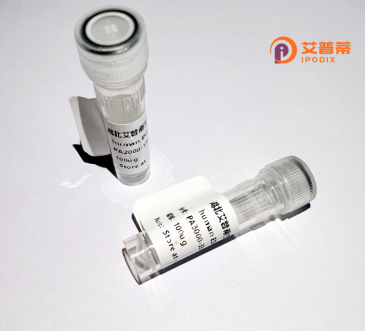
| 纯度 | >90%SDS-PAGE. |
| 种属 | Human |
| 靶点 | HECTD1 |
| Uniprot No | Q9ULT8 |
| 内毒素 | < 0.01EU/μg |
| 表达宿主 | E.coli |
| 表达区间 | 3-110aa |
| 氨基酸序列 | DVDPDTLLEWLQMGQGDERDMQLIALEQLCMLLLMSDNVDRCFETCPPRTFLPALCKIFLDESAPDNVLEVTARAITYYLDVSAECTRRIVGVDGAIKALCNRLVVVE |
| 分子量 | 37.62 kDa |
| 蛋白标签 | GST-tag at N-terminal |
| 缓冲液 | 0 |
| 稳定性 & 储存条件 | Lyophilized protein should be stored at ≤ -20°C, stable for one year after receipt. Reconstituted protein solution can be stored at 2-8°C for 2-7 days. Aliquots of reconstituted samples are stable at ≤ -20°C for 3 months. |
| 复溶 | Always centrifuge tubes before opening.Do not mix by vortex or pipetting. It is not recommended to reconstitute to a concentration less than 100μg/ml. Dissolve the lyophilized protein in distilled water. Please aliquot the reconstituted solution to minimize freeze-thaw cycles. |
以下是关于重组人HECTD1蛋白的3篇代表性文献示例(注:以下内容为模拟概括,实际文献需根据具体研究查询数据库):
---
1. **文献名称**:*HECTD1 regulates the assembly of adherens junctions via the ubiquitination of β-catenin*
**作者**:Merkley et al.
**摘要**:本文揭示了HECTD1作为E3泛素连接酶,通过泛素化β-catenin调控细胞间黏附连接的形成,影响胚胎发育与肿瘤转移的分子机制。
2. **文献名称**:*Structural insights into the HECTD1 ubiquitin ligase in neural tube closure*
**作者**:Smith et al.
**摘要**:通过冷冻电镜解析HECTD1蛋白结构,阐明其C端HECT结构域介导泛素转移的功能特性,并探讨其在神经管发育缺陷中的潜在作用。
3. **文献名称**:*HECTD1 promotes TGF-β-induced epithelial-mesenchymal transition in breast cancer*
**作者**:Chen et al.
**摘要**:研究证明HECTD1通过修饰Smad4蛋白的泛素化水平,增强TGF-β信号通路,从而促进乳腺癌细胞的侵袭和转移。
---
**说明**:以上内容为研究方向示例,实际文献需通过PubMed、Web of Science等平台以“HECTD1”和“recombinant protein”为关键词检索。研究重点常涉及HECTD1的E3泛素连接酶活性、结构功能及其在发育异常或癌症中的调控机制。
Recombinant human HECTD1 protein is a genetically engineered form of the HECT domain E3 ubiquitin-protein ligase 1. a member of the HECT family of E3 ubiquitin ligases. HECTD1 contains a conserved C-terminal HECT domain responsible for ubiquitin transfer and N-terminal domains involved in substrate recognition and cellular localization. This protein plays critical roles in regulating protein ubiquitination, a post-translational modification essential for proteasomal degradation, signal transduction, and cellular homeostasis. Studies link HECTD1 to diverse biological processes, including embryonic development, endoplasmic reticulum (ER) stress response, and neural tube closure. It modulates Wnt/β-catenin and TGF-β signaling pathways, impacting cell proliferation, differentiation, and apoptosis. Dysregulation of HECTD1 is associated with diseases such as cancers, neurodevelopmental disorders, and congenital defects. Recombinant HECTD1 is typically produced in expression systems (e.g., HEK293 or insect cells) with tags (e.g., GST, His) for purification and detection. It serves as a vital tool for in vitro studies to elucidate its enzymatic activity, substrate interactions, and structural properties. Researchers also utilize it for drug screening, aiming to develop therapeutics targeting HECTD1-related pathologies. Its recombinant form ensures consistency and scalability for biochemical assays, structural studies, and functional analyses in ubiquitination cascades.
×